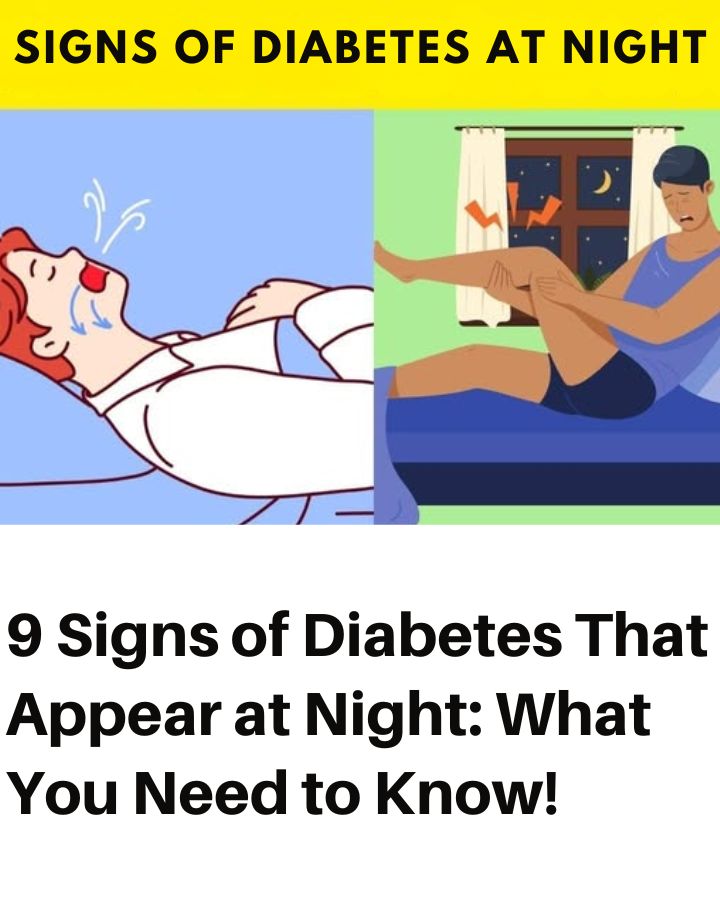Understanding the nocturnal manifestations of diabetes is crucial for early detection and effective management. Recognizing these nighttime symptoms can lead to timely interventions, potentially preventing serious complications. Here are nine signs of diabetes that often present themselves during the night:

1. Frequent Urination (Nocturia)
One of the hallmark symptoms of diabetes is increased urination, particularly during the night. Elevated blood sugar levels force the kidneys to work harder to filter and absorb excess glucose. When they can’t keep up, this surplus glucose is excreted into the urine, drawing fluids from tissues and leading to more frequent urination. This can disrupt sleep and is often an early indicator of diabetes.
2. Night Sweats
Experiencing excessive sweating during the night can be a symptom of nocturnal hypoglycemia, or low blood sugar during sleep. This occurs when blood sugar levels drop too low, triggering the body’s release of stress hormones like adrenaline, which can cause sweating. If you frequently wake up drenched in sweat, it may be a sign of diabetes-related blood sugar fluctuations.
3. Hypoglycemia Symptoms
Beyond night sweats, nocturnal hypoglycemia can manifest through various symptoms, including:
-
Trembling or shaking
-
Nightmares
-
Restless sleep
-
Morning headaches
These symptoms result from the body’s response to low blood sugar levels during sleep and can significantly disrupt rest.
4. Restless Legs Syndrome (RLS)
RLS is characterized by an uncontrollable urge to move the legs, often accompanied by uncomfortable sensations. There’s a notable link between RLS and diabetes, primarily due to diabetic neuropathy—nerve damage caused by prolonged high blood sugar levels. This nerve damage can lead to the restless sensations experienced in RLS, particularly during periods of inactivity like nighttime.
5. Sleep Apnea
Sleep apnea, a condition where breathing repeatedly stops and starts during sleep, has been associated with diabetes. Obesity, a common risk factor for type 2 diabetes, often contributes to obstructive sleep apnea by causing fat deposits around the upper airway, leading to breathing difficulties during sleep. This can result in poor sleep quality and daytime fatigue.
6. Increased Thirst (Polydipsia)
Excessive thirst, especially noticeable at night, is a common symptom of diabetes. As the body loses more fluids through frequent urination, it tries to compensate by triggering thirst. This cycle of dehydration and rehydration can disrupt sleep and is a key indicator of elevated blood sugar levels.
7. Persistent Fatigue
Despite getting adequate sleep, individuals with diabetes may experience ongoing fatigue. This stems from the body’s inability to effectively utilize glucose for energy due to insulin resistance or insufficient insulin production, leading to feelings of tiredness and lethargy.
8. Dry Mouth (Xerostomia)
High blood sugar levels can reduce saliva production, resulting in a dry mouth. This can cause discomfort, increase the risk of dental issues, and often leads to waking up during the night to drink water, thereby interrupting sleep.
9. Sleep Disturbances
Diabetes can lead to various sleep issues, including insomnia. Fluctuations in blood sugar levels—either too high (hyperglycemia) or too low (hypoglycemia)—can cause discomfort, night sweats, frequent urination, and other symptoms that disrupt sleep patterns.
Additional Early Warning Signs of Diabetes
Beyond nighttime symptoms, there are other early indicators of diabetes that should not be overlooked:
-
Darkened Skin Patches: Acanthosis nigricans presents as dark, velvety patches of skin, typically in body folds like the neck, armpits, or groin. This condition is often associated with insulin resistance and can be a precursor to diabetes.
-
Unintended Weight Loss: Losing weight without trying can occur in individuals with diabetes, as the body may start breaking down muscle and fat for energy when it can’t access glucose effectively.
-
Blurred Vision: Elevated blood sugar levels can cause the lens of the eye to swell, leading to temporary vision changes like blurriness.
-
Slow-Healing Wounds: High glucose levels can impair circulation and affect the body’s natural healing process, resulting in cuts, bruises, or sores that take longer to heal.
-
Tingling or Numbness: Peripheral neuropathy, caused by prolonged high blood sugar, can lead to tingling, numbness, or pain in the hands and feet.
Conclusion
Recognizing these nocturnal and early warning signs is vital for the timely diagnosis and management of diabetes. If you or someone you know is experiencing these symptoms, it’s important to consult a healthcare professional. Early detection and intervention can significantly improve quality of life and reduce the risk of serious complications associated with diabetes.





